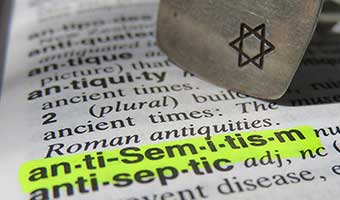|
|
|
|
 |
| Young girls at the olive groves of Sindyanna of Galilee, a woman-run, Arab-Israeli social enterprise in northern Israel. |
|
With fire consuming much of Australia, deadly floods ravaging central Israel, and the thermometer here in New York looking more like June than January some days, I’ve been thinking a lot about weather — and about Honi the Sage.
Honi is not a modern meteorologist, of course, but a Talmudic character who was walking along a road and saw a man planting a carob tree. Honi asked the man how long it would take for the tree to bear fruit, and the man replied, "Seventy years." Honi asked him: "Are you so healthy a man that you expect to live that length of time and eat its fruit?" The man answered: "I found a fruitful world because my ancestors planted it for me. Likewise, I am planting for my children."
The Jewish month of Shevat starts Sunday at sundown, and the 15th day, Tu b’Shevat, is what the Talmud called the New Year for the Trees. It’s listed right up there with Rosh Hashanah. In ancient Israel, it was central to the observance of agricultural laws.
Growing up, I barely acknowledged Tu b’Shevat — it seemed like a really minor holiday, something hippy and exotic. At best, it was an excuse to eat a weird fruit as we trudged through the American winter until spring.
But this year I’m thinking about the holiday differently, and seeing the whole month as an opportunity to reflect on our collective responsibility for the earth. In particular, I’ve been pondering the Jewish perspective on the female connection to the earth. Doesn’t it seem like it is largely young women — including Jamie Margolin — who are the faces of the fight for environmental consciousness today?
Traditionally, according to Genesis, it was Adam who was the gardener, the planter — a role inextricably tied to a curse, for his sin of eating the forbidden fruit.
But what about Eve? Is Eve possibly then given the opportunity of relating to the earth and its bounty in a different way than Adam? While Adam is created from the adamah, from soil, she is created from his flesh — and perhaps that degree of separation from the earth allows Eve to appreciate it all the more. While Adam’s relationship to the environment may be complex — he is commanded to toil over it, in a ruthless battle to yield fruit — that of his partner’s might be that much more liberated.
Perhaps, perhaps, our tradition is suggesting that women have the capacity to rise above the grind of daily labor, to look ahead — and to think about the next generation.
Wishing you a fruitful Shevat, and hope you enjoy this first installment of OUR TIME.
Avital Chizhik-Goldschmidt
|
|
Shira Barzilay, @koketit, is a Tel-Aviv based artist and “animal-loving vegan” who creates visually-striking portraits combining her love for fashion design and art. We find her work thought-provoking and tres Tel Aviv.
|
|
 So many books, so little time. This month, we’re celebrating the first year of a new decade by reading “Cosella Wayne, Or, Will and Destiny” — wait for it...the first American-Jewish novel, published in 1860. Yes, a woman wrote the first American-Jewish novel! Her real name: Henrietta Pulfermacher. Never heard of it? Don’t feel bad; almost no one has. Or had, until Prof. Jonathan Sarna of Brandeis University found it in 2016 while doing research in an Israeli archive; a new paperback edition was published last year with his introduction. So many books, so little time. This month, we’re celebrating the first year of a new decade by reading “Cosella Wayne, Or, Will and Destiny” — wait for it...the first American-Jewish novel, published in 1860. Yes, a woman wrote the first American-Jewish novel! Her real name: Henrietta Pulfermacher. Never heard of it? Don’t feel bad; almost no one has. Or had, until Prof. Jonathan Sarna of Brandeis University found it in 2016 while doing research in an Israeli archive; a new paperback edition was published last year with his introduction.
Have a book or film you’d like to share with our readers? Thoughts about this month’s selection? Write to us: ourtime@forward.com.
|
|
Meet fashion blogger Elizabeth Savetsky, also known as the “Excessories Expert,” our style icon of the month, who brings some much-needed color to our dreary January morning:
|
|
For my everyday look, I need my outfit to be both functional and fashionable. I’m constantly on the go, from carpool to the gym to lunch meetings to shoots. Here are my 7 go-to style elements.
✓ Statement outerwear. If you have a great coat on, it doesn’t matter if you have pajamas underneath!
✓ Western boots. Maybe it’s my year in Dallas, but I have been so inspired by western pieces and they have been all over the runways as well! I love them because they start a conversation, and bring a glamorous look down to earth.
✓ Huge sunglasses. I usually don’t wear much makeup unless I am doing photos or going out at night. I count on big sunglasses because I think they are the most glamorous way to hide tired eyes in the carpool line.
✓ Layered jewelry. In my daily life, I layer a few delicate necklaces. I also have nine piercings so my ears are full of diamond huggies and tiny studs; these days, I’m having a celestial moment with lots of stars, moons, and lightning bolts.
✓ A fabulous handbag. The best investment is a designer handbag. My grandma and my mom have held on to all other theirs, and I raid both of their collections; I especially love the vintage Judith Leiber bags. A bag doesn’t get worn out like a pair of shoes, and it’s much more practical than an expensive piece of jewelry.
✓ Bling. I grew up going to the Miss Texas pageant, so my affinity for huge sparkly earrings and false eyelashes was deeply ingrained in me from childhood. And to this day, I have never met a sequin I didn’t love. I’ve never been afraid for people to take notice when I walk in a room.
✓ Tribal symbols. If you take one look at my jewelry, you can see that I am a proud Jew: I wear a “L’Chaim” necklace from Jennifer Zeuner; a diamond Hebrew letter “Pay” necklace from the Israeli designer, Hot Crown, for my Hebrew name, Pesha; and a gold dog tag that says “schvitz” from Van Der Hout Jewelry. I also wear a ring that says “KOSHER” in big gold letters. My most precious possession is a gold coin that my great-grandfather gave my great-grandmother, for whom I am named. It reminds me of the sacrifices the people before me made so I could be here today.
Who’s your Jewish style icon? Nominate her here.
|
|
Spending time in nature — yes, even in the winter — is good for you. According to a recent study by British scientists, it takes 120 minutes a week outdoors to get the full health benefits of nature. Plus, for those of you who feel overworked, take note: Research also shows that time spent in nature can reduce stress, anxiety and fatigue.
Dr. Hagai Levin, of the School of Public Health at the Hadassah Medical School at Hebrew University, told us that soon, doctors may prescribe to their patients not just pills — but time in nature. “Now, more than ever, as the majority of the world population resides in cities, it's essential that we all have easy and free access to the natural environment,” he said. ”Most people don't need to take along a blood pressure cuff to know that they feel happier, more relaxed and invigorated in fresh air and among forests and inspiring landscapes.”
Duly noted, Dr. Levin. We’ll take an Rx for an ambling walk in Central Park any day.
Read more medical stories like this at hadassah.org/news.
|
|
1. A savory Yemini spice blend of cumin, black pepper, cardamom, coriander and turmeric popular in Israel that will take your chicken soup to the next level, just in time for flu season.
2. A sweet Yemini spice blend: ginger, cardamom, cinnamon, clove. Use it to turn your coffee into dessert.
|
|
|
Let us know how you used hawij. And don’t keep your ingredient secret -- share it here
|
|
🎙️ Tune in to Hadassah’s The Branch podcast, hosted by the American-Israeli journalist Dina Kraft, for a closeup on an unlikely duo: Yuval Ben-Ami, son of an Israeli army spokesman, and Husam Jubran, who spent a year in a wheelchair after being shot by Israeli soldiers as a teenager. The two team up as tour guides for a powerful experience crisscrossing the two narratives of the Israeli-Palestinian conflict. Sign up for new episode alerts here.
📜 For two years, Avital tried to convince a rabbi running an underground Talmud class for Haredi women in Jerusalem to let her join. He finally relented. Read the article.
📺 Of course, we’re all gearing up for Fauda’s third season, which we expect to come to Netflix in several months. In the meantime, here’s the Forward’s definitive guide to what Israeli TV and films to stream.
✈️ Did you know that Louisa May Alcott may have had Portuguese Jewish ancestry? Take a fascinating stroll through once-Jewish Lisbon streets with Alcott’s cousin and biographer Eve LePlante.
📱This month, we chatted with Bracha Bard-Wigdor, a birth doula and intimacy coach, who has taken to Instagram to teach sex ed to fellow Orthodox Jewish women. No filters.
🤣 Next month, we’ll be talking about comedy, because Purim. A meme or joke you love? A female Jewish comedian you follow? Send it to us! ourtime@forward.com
What are you reading, listening to and watching online these days? Let us know: ourtime@forward.com
|
|
 |
| Every month, we’ll highlight a photograph from the Forward or Hadassah archives. This month, our eyes lingered over this beautiful moment: A woman from an African-American Jewish community in Harlem lighting Sabbath candles. Originally published in the Forverts on January 5, 1941. |
|
If the little things make you happy, you’ll never be sad — that’s one of our mantras. And that’s why we like type. Your newsletter was set in a typeface called Helvetica, designed in 1957 by Max Miedinger, to appear dense, solid and clean. There’s even a movie about it. Thanks Max! This newsletter was edited by Helen Chernikoff and designed by Angelie Zaslavsky. |
|
You’ll only get next month’s OUR TIME if you sign up:
|
|
Got a friend who might enjoy it, too? Please forward widely, or click here for a Web version you can share on social media. Happy Shevat!
|
|
|
|
|
|
|
|
|
















